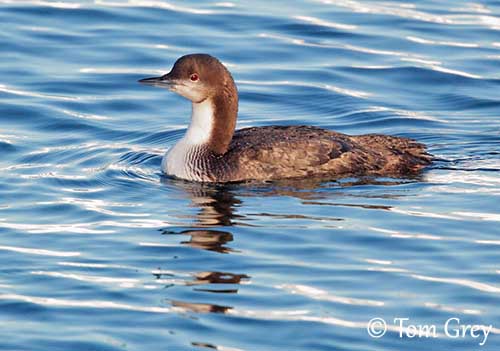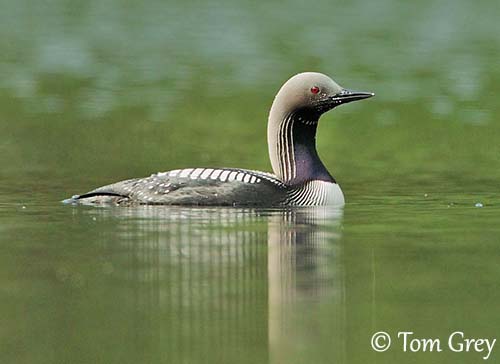
Fr: Plongeon du Pacifique, Huart du Pacifique
Ang: Pacific Loon, Pacific Diver
All: Weißnackentaucher
Esp: Colimbo del Pacífico
Ita: Strolaga mezzana del Pacifico
Nd: Pacifische Parelduiker
Sd: Stillahavslom
Photographers:
Tom Grey
Tom Grey's Bird Pictures
Ken Havard
My Bird Gallery & Flickr gallery 1 & Flickr gallery 2
Text by Nicole Bouglouan
Sources:
HANDBOOK OF THE BIRDS OF THE WORLD vol 1 by Josep del Hoyo-Andrew Elliot-Jordi Sargatal - Lynx Edicions - ISBN: 8487334105
BirdLife International (BirdLife International)
Bird Web (Seattle Audubon Society)
Animal Diversity Web (University of Michigan Museum of Zoology)
What Bird-The ultimate Bird Guide (Mitchell Waite)
All About Birds (Cornell Lab of Ornithology)
Page Family Gaviidae
Summary cards
Pacific Loon or Pacific Diver
Gavia pacifica
Gaviiformes Order – Gaviidae Family
INTRODUCTION:
The Pacific Loon was formerly a subspecies of the Black-throated Diver. It is now a separate species. This is probably the most abundant loon in North America, and most of them winter along the Pacific Coast. More gregarious than other Gaviiformes, this one can be found in large flocks at abundant food sources and during migration.
DESCRIPTION OF THE BIRD:
Biometrics:
Length: 61 cm
Wingspan: 109-122 cm
Weight: 1680 g
The adult in breeding plumage has chequered black-and-white back. Wings and tail are black, with small white spots on the flight feathers.
The underparts, breast and belly, are white.
Head and hind neck are silvery-grey, but the forehead is darker. The foreneck is black, bordered on each side by several vertical black-and-white stripes. The throat shows short, vertical, black-and-white stripes, forming a partial collar. The white upperbreast sides are striped black.
The black bill is straight, pointed, dagger-like, and thinner than in the Black-throated Diver. The eyes are deep red to reddish. Legs and webbed feet are dark grey-green.

The adult in winter plumage is duller with brownish-grey upperparts and white underparts. We can see a dark border dawn the neck sides, between the white chin and foreneck and the dark grey hindneck. The adults may have a narrow, dark, partial collar at throat base.
The bill is usually greyer than in breeding plumage.
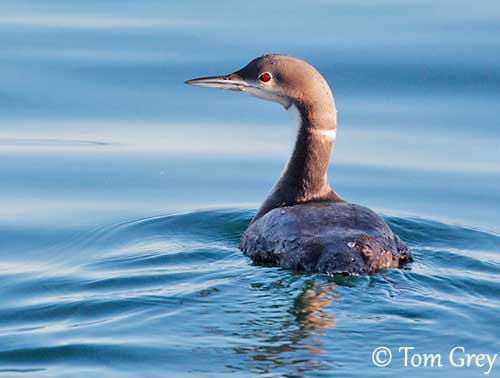
Both sexes are similar, but the female is slightly smaller than the male.
The juvenile resembles adult in winter. It has brown to dark grey upperparts whereas the underparts are white, including the throat. On the upperparts, feathers are usually edged pale buff. The eyes are dark.
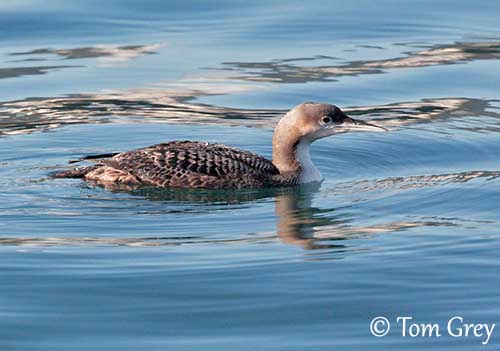
RANGE:
The Pacific Loon breeds on the coasts of NE Russia, Aleutians, Alaska and N Canada. It migrates southwards to the coasts of the Pacific Ocean S to Japan and Korea, and in America, to NW Mexico (Baja California).
This species is very rare in NE United States, and vagrant in Greenland and Great Britain.
HABITAT:
The Pacific Loon breeds on freshwater lakes and ponds in tundra and northern forests. It favours large lakes with little submerged vegetation, but with small islands and islets for nesting.
It winters at sea but in coastal waters, and can be found in bays, inlets and estuaries.
During the migration, it rests on the open ocean.
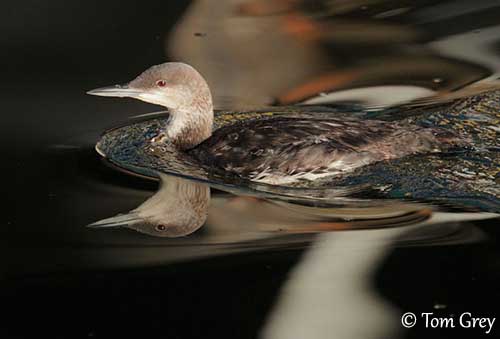
CALLS AND SONGS: SOUNDS BY XENO-CANTO
The Pacific Loon is usually silent in winter. However, during the breeding season, it utters repetitive, hoarse croak “kok-kok-kok-kok” and deep barking calls “kwow”.
On the breeding grounds, it produces wailing notes rising in pitch.
BEHAVIOUR IN THE WILD:
The Pacific Loon feeds primarily on small fish often caught after a pursuit underwater. The prey is usually swallowed underwater except for spiny or larger ones which are carried out of water where they are disabled before being eaten.
But other preys such as frogs, crustaceans, molluscs (water snails and cephalopods), annelids and larvae of aquatic insects are included in its diet. Fish spawn are also taken, and occasionally plant matter too.
The fish can be taken in the ocean and all year round. The other prey items depend on habitat types and seasons.
The Pacific Loon dives in search of food at depths ranging between two and ten metres. It can remain about 45 seconds underwater, but these birds are able to remain submerged for several minutes. They propel themselves with their feet. The wings are only used to help in turning movements.
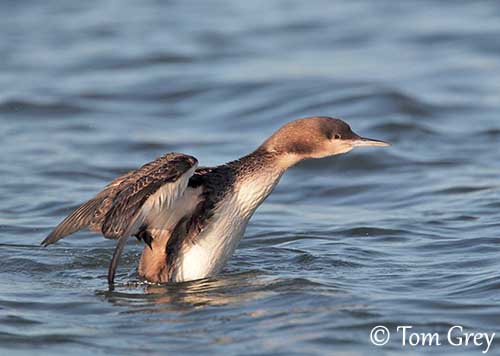
During the breeding season, the birds perform simple courtship displays, swimming and diving in pairs while moving their heads. Other synchronized displays are performed on and under water. Copulation occurs on dry land and is frequently repeated.
The nest-site is often selected by the male, usually with ample views on the surroundings, and wide area of open water for easier escape. They are monogamous with long-term pair-bonds, and they return to the same breeding grounds and nest-sites year after year.
The male gives characteristic loud and fascinating advertising calls to maintain the territory and strengthen the pair-bonds.
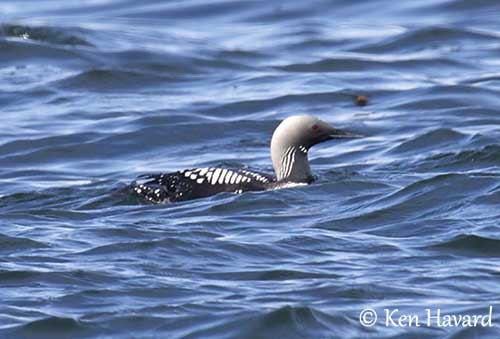
The Pacific Loon is migratory, and unlike other loon species, the birds may migrate in flocks.
In spite of its large wingspan, the Pacific Loon cannot take off from land. It performs a long run over the water (30-50 metres) while flapping the wings vigorously to rise above the surface. They are good fliers and can travel long distances, flying both over land and over water, and at great heights.
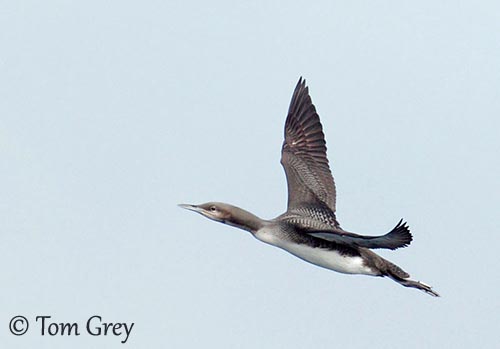
REPRODUCTION OF THIS SPECIES:
The breeding season occurs in spring and summer, and usually starts in March.
The nest is a shallow depression on the ground with some vegetation, or a bowl of aquatic vegetation and grasses, close to the water. It is placed mainly on small islands and islets when available, but the water levels may sometimes destroy or flood the nest-site. Both sexes build the nest, and fresh materials are added during the incubation.
The female lays 1-2 olive-green to brownish eggs. The incubation is shared by both adults during 28-30 days. The chicks leave the nest very soon after hatching, and they can be seen riding on adults’ back for protection, but they are able to swim. However, they are brooded on dry land for the first days. The adults feed them until they are fully-grown. They fledge about 50-55 days after hatching. This species raises only one clutch per season.
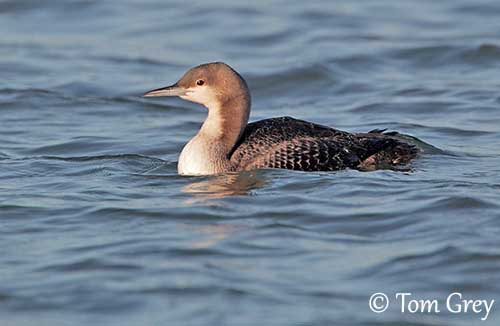
PROTECTION / THREATS / STATUS:
The Pacific Loon has large range where the population is suggested to be increasing.
Some threats such as disturbances, water pollution, fishing line and water levels could affect the species.
But currently, the Pacific Loon is evaluated as Least Concern with a global population estimated at about 930,000/1,600,000 individuals.
